UPDATES ON COVID-19 FROM HOUCK
To our employees, business partners, vendors, community leaders, and friends,
We hope that you are staying safe and that you are able to maintain operations and activity as normally as possible during this difficult time. The news and situation surrounding the COVID-19 virus is rapidly and constantly evolving, and we are all working our way through the challenges and decision-making processes associated with it. The health and safety of our employees, business partners and vendors is of paramount importance to us as we navigate our way through this crisis.
We are very grateful to say that our workforce has not been directly impacted by the COVID-19. At this time, we have no known cases within our staff. As it stands now, we are in the position to maintain operations and continue to provide high levels of service and responsiveness, while maintaining safe work environments for our customers and employees. We will not; however, put anyone at risk, and we will do our best as a company and as individuals to prevent the potential spread of this virus by practicing and exploring the following:
- We are investigating alternating work days for administrative positions to reduce the number of people in the office.
- We are encouraging work-from-home options – where and when feasible.
- With regard to field proceedings, we are attempting to keep as many projects operational as possible – while keeping within the specific mandates of our customers.
- Superintendents are remaining mobile and working from their trucks – where and when possible.
- The leadership team, where possible, is planning on being in the office.
- Meetings in general will be held only as absolutely necessary and with less than 10 people in attendance.
- Operational meetings will be handled remotely – where possible.
- Virtual meetings and teleconferencing are strongly encouraged in place of face-to-face events.
For our customers:
When at all possible, we will access our worksites via exterior access as to not enter the building unless absolutely necessary. When our work requires access into our customers’ buildings, our staff has been instructed to follow guidelines outlined by the CDC, including practicing social distancing.
While much of our communication throughout the project process can be done electronically via phone, e-mail, or video chat, we recognize that in-person meetings may still be required. Should we need to meet with you or someone associated with the particular project or work being performed, we will respect your space and time, and take the proper safety precautions.
For our employees:
In addition to the above procedures, we are asking all Houck employees to practice the following standard precautions to reduce the potential spread of the virus and minimize risk:
- If an employee is sick, we’re asking that you please stay home.
- Any employees displaying symptoms while at work or on a job site will be asked to leave.
- Cover any coughs or sneezes with your elbow (vampire cough) or cough into a tissue or disposable product that is immediately thrown into a waste basket.
- Wash hands often (for at least 20 seconds and before eating.)
- Use hand sanitizers often and refrain from touching your face.
- No more handshakes. We ask all employees to practice overall “no-contact” behaviors.
- Please take measures to continually disinfect door handles, handrails, printers and copiers, eating areas and community spaces, buzzers, buttons, light switches, etc.
- Limit travel, when possible, and practice social distancing.
- Temporarily discourage visitors and vendors from visiting the office.
- If you have a sick family member, please notify your supervisor so Houck can do a risk assessment.
This is a stressful time. If you are experiencing anxiety issues and would like to speak with a professional, please remember to take advantage of the Employee Assistance Program (EAP) available to Houck employees.
Please reference a more comprehensive list of precautions and guidelines at https://www.cdc.gov, https://www.who.int, https://www.hhs.gov, and https://www.health.pa.gov/Pages/default.aspx
Remember, we are all in this together, and we will get through it. Thank you for your understanding and patience as we all work together during this challenging time. We are always available for your questions. Please don’t hesitate to reach out.
How To Select A Specialized Commercial Contractor
When it comes to selecting a quality, specialty contractor for your facility, it’s best to go with commercial installation professionals that are knowledgeable about the latest products and industrial applications and have a good history of related experience. While some contractors only specialize in one area, like roofing, others specialize in a multitude of areas like:
- Masonry
- Concrete
- Industrial flooring
- Industrial fabrication
- And more
The advantage of selecting a contractor with credible specializations in multiple fields is efficiency. You can utilize one contractor who knows you, your business, your preferences and your vision to get the job done from floor to roof. Sometimes the right choice comes right down to trustworthiness, the ability to deliver a quality product, the ability to get the project done on-time and within budget and the integrity to stand behind the work performed.
Although budget is vital in the overall planning and selection process, the adage “you get what you pay for” rings true more often than not when selecting a contractor with experience in industrial roofing, masonry or another field that requires significant skill. The roof over your head and the floor under your feet should be something you can rely on. That sense of peace comes from hiring credible industrial roofing technicians or commercial floor installers who know what they are doing.
Qualities To Look For In A Commercial Contractor
Longevity – How Long Has The Contractor Been In Business?
It’s wise when considering a commercial contractor to look at how long they have been in business and how well they have maintained their reputation. In this industry, longevity really means something. Contractors who consistently provide quality roofing, flooring or masonry work tend to get good reviews and great word of mouth. Those who skimp on quality tend to fall out of the mainstream quickly.
Reputation – Does The Contractor Have A Good Reputation?
In the building maintenance, facility maintenance and building preservation industry, word spreads fast. Choosing a commercial contractor can be as easy as keeping your ears and eyes open. Do you see that company’s trucks or vans around often? Have you seen the company working on facilities near you? What do their online reviews say?
Whether you’re a director of facilities for a retirement community, a maintenance manager for a school district, or a commercial property manager, you have a network of contacts and colleagues… use them! Ask your network about commercial building contractors that they recommend, and – equally important – which ones they would suggest steering clear of. Pair that with what you see around town and Facebook or Google reviews to get a better understanding of contractors you should reach out to.
Certifications – Do You Need A Certified Contactor?
The resounding answer is YES! It’s important that the industrial contractor you select possess the appropriate certifications. Is your commercial roofer and commercial roof maintenance service provider officially certified by the manufacturer of the commercial roofing system they are installing or servicing? How can you tell? Look for certifications with the products they’re working with like:
A commercial roofing company that installs or performs roof repairs without being certified by the manufacturer of that roofing system can prevent the possibility of obtaining a roof warranty; and, in the case of roof repairs performed by an uncertified contractor, can possibly void a perfectly good roof warranty. Certifications give you the peace of mind that the job can be done right the first time and any follow up in the future will be as painless as possible.
The same goes for masonry restoration technicians, concrete repair contractors and industrial welding, fabrication and installation technicians. Make sure to ask your contractor:
- Do they have their R-Stamp certification?
- What do their safety certifications include?
These are all good questions to ask.
Safety – How Important Is Safety When Selecting A Contractor?
The short answer is extremely. Safety should always be at the forefront of the decision-making process for a commercial specialty contractor. Look for specialty contractors that have an established plan for maintaining safe job sites – contractors that take safety very seriously. Select contractors that are recognized by their insurance carriers, OSHA and many other local associations and peer groups for their dedication and commitment to safety. While a contractor is working in your facility, the last thing you want is injury to one of your employees or a jobsite accident with your contracting team that will carry your company name.
Quality
Quality is assessed on many levels when selecting any contractor, no matter the specialty. The determination of quality for a roofing contractor is vastly different than that of a masonry restoration contractor. Past projects and repeat clientele can speak directly to the quality of their work and craftsmanship. Take a look at your prospective contractor’s website or online presence for images and proof of their work. If you are looking for a commercial floor installer, look for images of work they have completed and decide if their final work matches the quality you are looking for. The same applies to masonry, roofing and other commercial construction.
In the long run, you would do well to choose a commercial specialty contractor that maintains high standards for its crews, a deep commitment to its trade and is committed to ongoing training to ensure its technicians are on the cutting edge of the latest products and industry solutions. If a commercial contracting outfit is willing to invest in the people it employs, they show a top down commitment to quality that ends with you, the customer.
How well your building maintenance project performs and how long it lasts – no matter what it is – depends on the contractor’s knowledge of quality installation methods, their certifications and their experience with their respective applications. Starting with quality helps ensure long term investments are long term solutions for your facility.
If you would like to learn more about us and our services:
- commercial roofing and maintenance service,
- industrial flooring,
- masonry and restoration services,
- as well as building preservation,
contact us at 717-657-3302 or follow us on Facebook, LinkedIn and Twitter.
Roof Replacement: What You Need to Know
Everything You Should Know About Roof Replacements
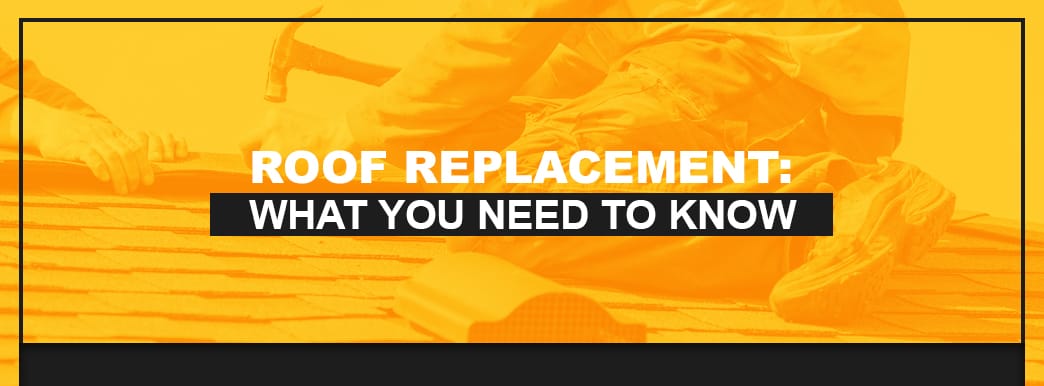
When to Replace Your Roof
- Your roof is leaking: One sign you may need a new roof is if your current one is leaking. You may notice leaks when water drips down through your ceiling or when your building starts to develop a musty smell. You may be able to repair leaks, but if your roof is springing leaks because it’s aging, you may need to replace it.
- The roof deck is damaged: When you think about the condition of your roof, you likely focus on what you can see, but the parts of your roof you can’t see are just as critical. Since decking is made from wood, it’s subject to issues like water damage and rot that can call for a roof replacement.
- Your roof is sagging: If your roof is sagging, this is a sure sign that something is wrong. One possibility is that your roof joists are too small or too weak to stand up to the weight of snow and ice that settles on the roof at times. A sagging roof is, at least, cause for repairs and may indicate it’s time to install a new roof.
- The shingles are deteriorating: If you have an asphalt shingle roof, you can usually tell it’s time to replace the roof when shingles are starting to crumble and deteriorate. This may lead to granules in your gutters. You may also notice dark streaks forming on shingles, which is a type of algae that tends to form with age.
- Your roof is due to be replaced: Finally, if your roofing material has reached the end of its lifespan, then you should consider replacing your roof. Any roofing material may be able to outlive its predicted lifespan with careful maintenance, but especially when it comes to cheaper materials like shingles, you should expect to replace your roof after two decades or less.
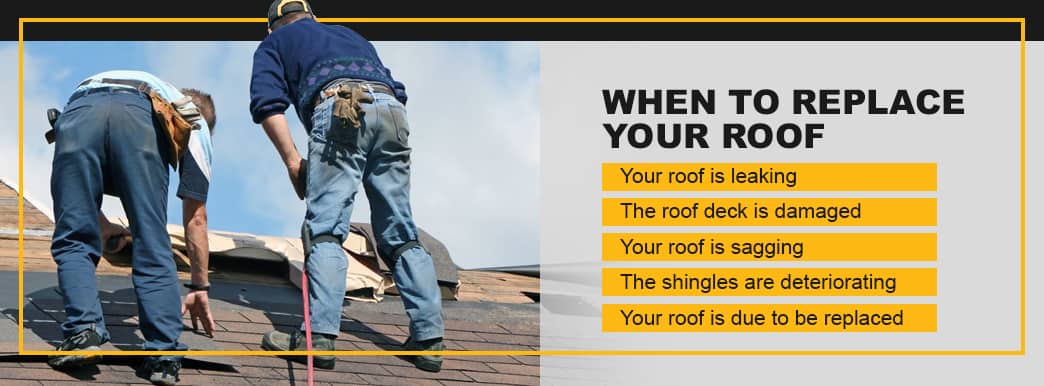
| Contact Us | Call Us |
What to Consider Before Replacing Your Roof
Are Coatings or Repairs an Option?
What Is Your Local Climate Like?
What Aesthetic Are You Going For?
Aesthetic tends to be more of a concern for homeowners replacing their home’s roof, but it should also be a concern for industrial and commercial property owners and managers, as well. Your chief concern may be functionality, but that doesn’t mean you need to ignore appearance. The best roofing system is one that protects your building and enhances the building’s overall aesthetic.
Consider the architectural style of your building and any colors you would like to feature or match. Some roofing types, such as built-up roofing, aren’t visible to people below and won’t afford much room for customization, but many other types of commercial roofing materials, such as rubber or metal, come in different colors and finishes. You may even want to set your building apart with a garden rooftop.
What Is Your Budget?
Another thing you’ll want to think through when you need to replace your roof is your budget. One way to think about your budget is to simply consider the amount you’re willing to spend and then choose an option that fits within that limit. Another approach that may serve you better in the long run, however, is to think of your new roof as an investment, the benefits of which you can continue to reap over time.
This may mean expanding your budget a bit to install a better quality roof. When you spend more now on a high-quality roofing system, you can save money in the long run since you likely won’t have to spend as much on repairs and will be able to wait much longer before replacing your roof again. Some roofing materials even have the potential to last a lifetime.
| Contact Us | Call Us |
Does Your Insurance Pay for a New Roof?
When you’re considering your budget for a new roof, you should check your insurance policy to see if it will cover the cost of a new roof. Home insurance policies often include provisions for roof replacements in the case of acts of nature. Commercial policies may also include coverage for either repairing or replacing a roof that has been damaged by things like insects, fire and storms.
Typically, insurance companies will not offer any assistance with roofs that are ready to be replaced after experiencing normal wear and tear, so this responsibility will fall on the property owner. Every policy is different, so you should check yours to see whether a new roof or roofing repairs may be covered.
Who Should You Hire to Install Your Roof?
Finally, you’ll need to think through who you’re going to hire to install your new roof. It’s in your best interest to work with a company like Houck, who will apprise you of all your options and won’t try to pressure you into paying for a full roof replacement when you may only need repairs. An experienced and fair roofing company will be able to consult with you and provide valuable input to help you settle on the best roofing solution for your building.
Check online reviews and talk to colleagues and friends who have had their roofs replaced recently to get some recommendations. Keep in mind, however, that, if your roofing project calls for a special set of skills, such as historical restoration, you may not want to go with a company your neighbor used. Instead, look for a company that specializes in your type of project.
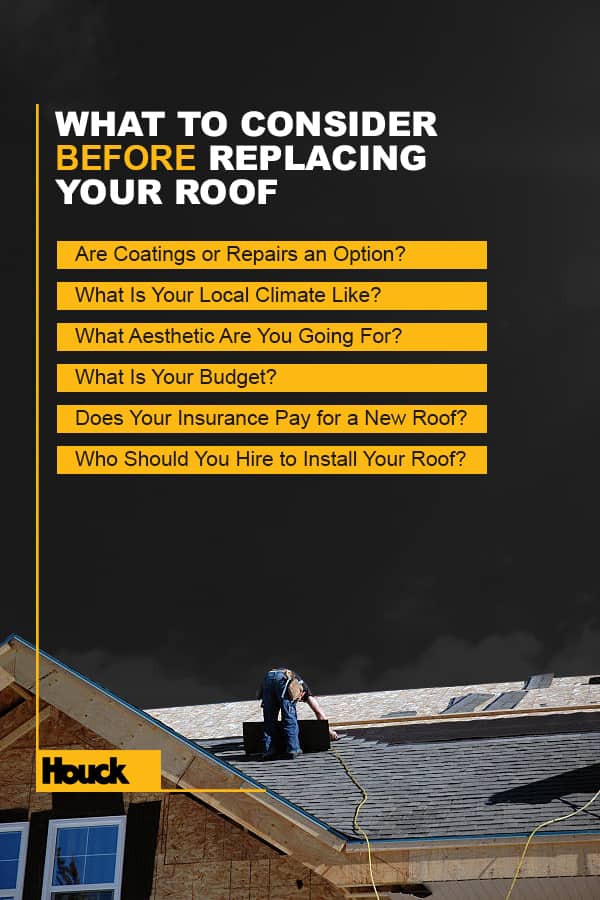
Getting a New Roof? Here’s What to Expect:
1. Inspection and Planning
The first week or more of the process will involve inspecting your current roof and making a plan. A craftsperson will take a close look at your current roof to determine whether replacing the roof is the best course of action and will then help you determine what type of roof to install. The roofing company should also provide you with a quote at this point to help you budget for your new roof.
2. Paperwork
Once you’ve planned your project, the next step is for your roofers to obtain the necessary permits. Most cities require building permits for roofing projects to make sure they abide by the relevant building codes. Another type of paperwork you should receive at this point is a written contract detailing the agreement between the roofing company and you. You should also ask for a written confirmation that your roofing company has the necessary insurance coverage for your project.
| Contact Us | Call Us |
3. Installation
The installation itself will likely go much faster than the planning and paperwork leading up to it. Depending on the size and type of roof, installation may take several days. Your roofing craftspeople may have to start by removing the old roof, depending on how many layers of surface material you have, what condition it’s in and whether they need to get to the decking to make repairs. Depending on the project, you may have to vacate your building during the roof installation
4. Clean-Up and Walk-Through
After your roof is installed, your roofing craftspeople will spend a day or so cleaning up. This typically includes disposing of the previous roofing material that was removed and collecting any debris lying around. Your roofers may also use a magnet to collect any screws, nails or other metal pieces on the ground. All these materials will go into a dumpster that will be hauled away. Finally, you should be able to do a final walk-through with your roofer to see the results of the project.
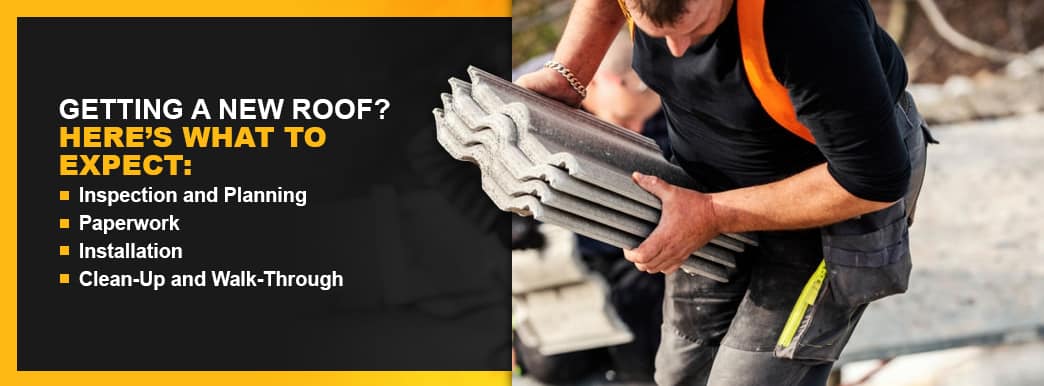
Preparing Your Roof for Replacement
- Cut the grass: Keeping your grass short will help your roofers mind any pieces that are dropped on the ground, including small objects like nails, screws and staples.
- Cut back trees: If there are any tree branches that are encroaching on your roof, you’ll need to prune these back to keep them out of the way for re-roofing. It’s also wise to maintain space between trees and your roof, so they don’t damage your roof.
- Move outdoor objects: You should also move objects like potted plants, outdoor furniture, ceramic landscaping features and anything else that could break if it were to be hit by a falling piece of debris from the roof. If you have a satellite dish on your roof, you’ll need to move this, too.
- Move vehicles: You’ll want to leave a large path on your driveway or parking lot for your roofers to come and go with materials. Moving vehicles to the other side of the parking lot or down the street will also help protect them from falling debris.
- Identify outlets: One way you can help streamline the process is by identifying the most convenient outlets ahead of time for your roofers to access for power tools. Outdoor outlets are ideal. If you only have outlets inside your home, you’ll need to run an extension cord outside.
- Clear out the attic: Gaps in your decking can allow objects and debris to fall through during the re-roofing process, so if you have an attic, you’ll want to either remove the items you have stored there or cover them with a tarp to ensure nothing gets damaged.
- Remove wall hangings: You may also want to take down wall hangings, especially if you’re having work done on the roof decking and not just the surface material. This will prevent pictures from falling down and breaking due to vibrations and impact from above.
- Notify neighbors: It’s courteous to speak with neighbors, whether neighboring homeowners or neighboring businesses, ahead of time to let them know you’ll be having some work done. This small gesture can go a long way toward preventing a disturbance.
| Contact Us | Call Us |
Houck Can Meet All of Your Roofing Needs
A roof replacement can be an involved process, but it’s sometimes a necessary step when your existing roof has come to the end of its lifespan. Keeping up with the health of your roof is critical, so you can ensure your roof continues to provide the insulation and protection your facility needs.

If you think your roof may need to be repaired, reinforced with a coating or replaced, you can trust Houck Construction in Central Pennsylvania for all your roofing needs. With over 70 years of experience, we can help answer any questions you may have about the industry or best roofing practices.
Contact Houck today to learn more about how we can help you enjoy the benefits of a top-quality roof.
What Are Risk Assessments and Factors in Construction?
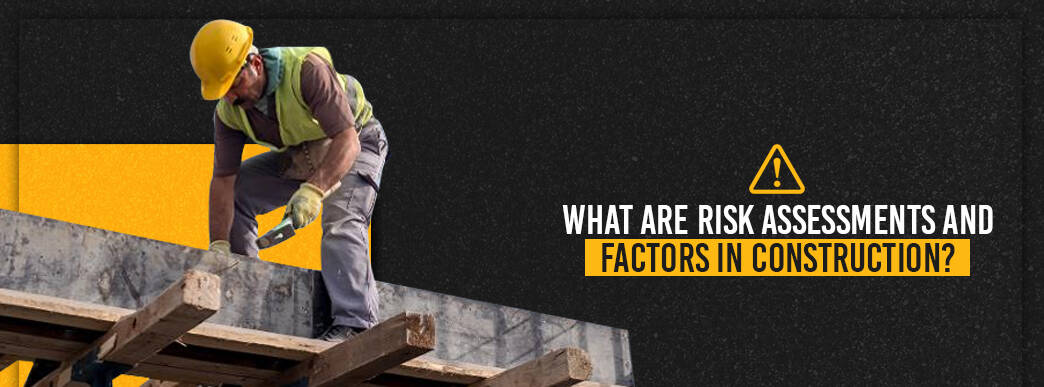
You have the right to expect your workplace to be safe and that you’ll be able to get through the workday without a severe injury or a significant accident. The same is true for nearly 7.5 million people who work in construction in the U.S.
Construction sites tend to be considerably different from other workplaces, such as offices or retail locations. They have a unique set of risks, which other industries might not even have to consider. The injury rate also happens to be higher in the construction industry compared to any other industry. In 2017, more than three out of every 100 workers in construction had an injury or illness, and more than 1,000 workers died.
Although it is impossible to entirely eliminate the risk of injury or death in any industry and from any job site, there are steps facility managers, building managers and commercial property managers can take to reduce any risk significantly. Performing a risk assessment before the start of any project, both while the project is ongoing and at the end, will help managers identify potential risks and develop a plan to mitigate or reduce those risks. A risk assessment helps managers determine how significant or severe a potential risk might be. It also helps managers avoid risks that can lead to financial harm.
Contact us today for a risk assessment and to start your next job. We identify and mitigate hazards and put protective measures, including signage and personal protective equipment, into place before we begin any job.
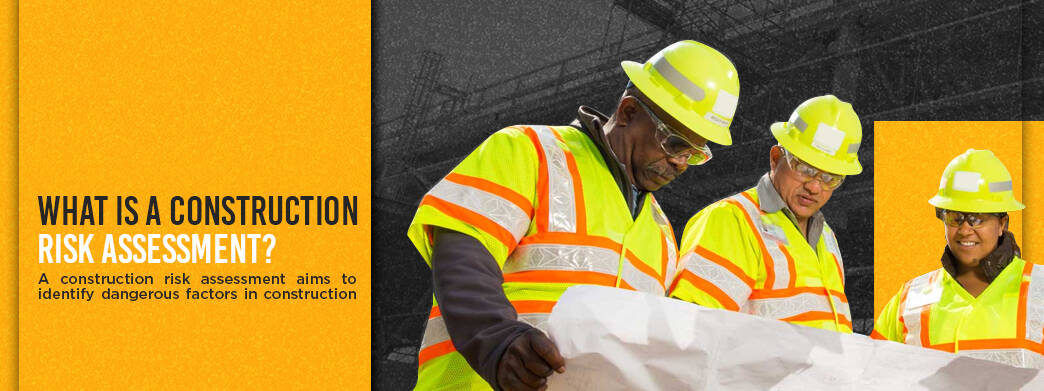
What Is a Construction Risk Assessment?
A construction risk assessment aims to identify dangerous factors in construction projects. Before discussing how and when a risk assessment is performed, it helps to define what a risk is. A risk is a chance that a hazard will cause someone injury, illness, harm or other damage.
Usually, risk assessment is a three-part process that involves:
- Identifying hazards
- Analyzing and evaluating risk
- Controlling the risk
While one of the goals of a risk assessment is the prevention of injuries, there are additional reasons to perform an assessment. A risk assessment allows you to:
- Determine who is at risk, such as employees or site visitors
- Raise awareness of the risk and any hazards
- Determine if existing measures are adequate for controlling the risk or if you need to take further action
- Decide if you need a particular control program for a hazard
- Fulfill any legal requirements, if applicable
When performing a risk assessment, it’s likely you’ll need to answer a series of questions. Finding an answer to your questions can help determine the best way to control specific liabilities and minimize hazards. A few of the things to ask as you perform the risk assessment are:
- What could happen?
- What circumstances need to exist for the hazard to be present?
- What are the consequences of doing nothing to correct the hazard?
- What is the likelihood of the consequences occurring?
- What can you do to control the risk?
- Are you effectively controlling the risk or do you need to take further action?
At Houck, we put safety first. It’s in our slogan: “Safety. Quality. Performance.” Get in touch with us for a risk assessment before starting your next project.
| Contact Us | Call Us |
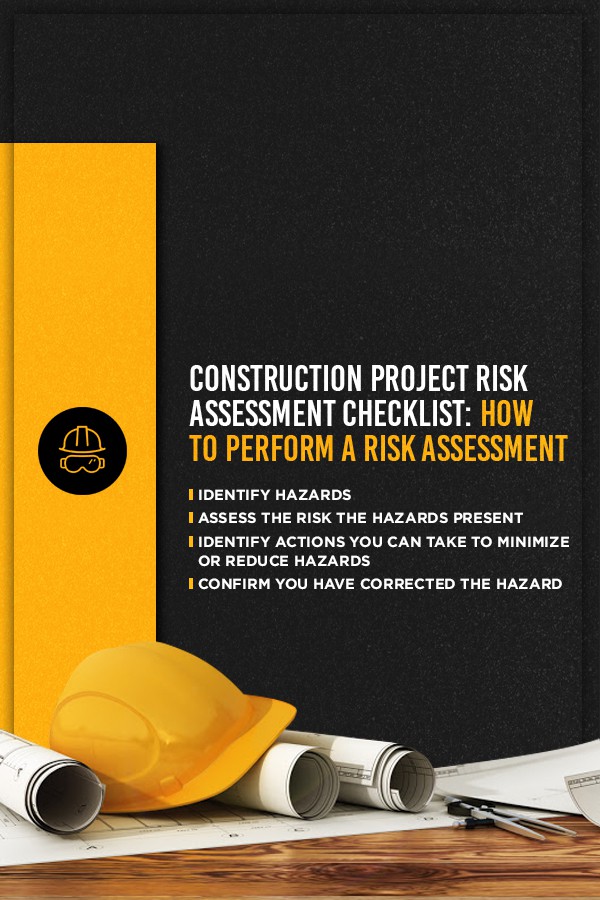
When to Perform Risk Assessment
There are multiple points during a construction project when it is appropriate to perform a risk assessment. The first point is before the project begins or during the design phase of the project. The second point is any time you introduce a new method or process to the project. For example, if your team brings a new piece of equipment on-site, it is a good idea to perform a risk assessment of the equipment to determine if it could cause injury or other issues.
Finally, another reason to perform a risk assessment is the identification of a hazard. This liability might be one your team missed during the initial assessments or one that arose unexpectedly. For example, there might be a thunderstorm that creates slippery conditions on the site. A risk assessment after a storm will analyze and evaluate how much of a threat the wet conditions pose to workers and others.
Types of Risk Assessment
Three types of risk assessment exist. Each type has a somewhat different aim and purpose, but each one might apply to a construction project.
Baseline Risk Assessment
A baseline risk assessment establishes a benchmark of the potential hazards that exist during a construction project. The goal of a baseline risk assessment is to identify the risks present, to rank each liability, and evaluate whether or not established control systems will effectively manage them.
Baseline risk assessments tend to be comprehensive and focus on any and all dangers that might be present during a project. After performing a baseline risk assessment, a manager can focus more closely on particular hazards or issues described in the assessment.
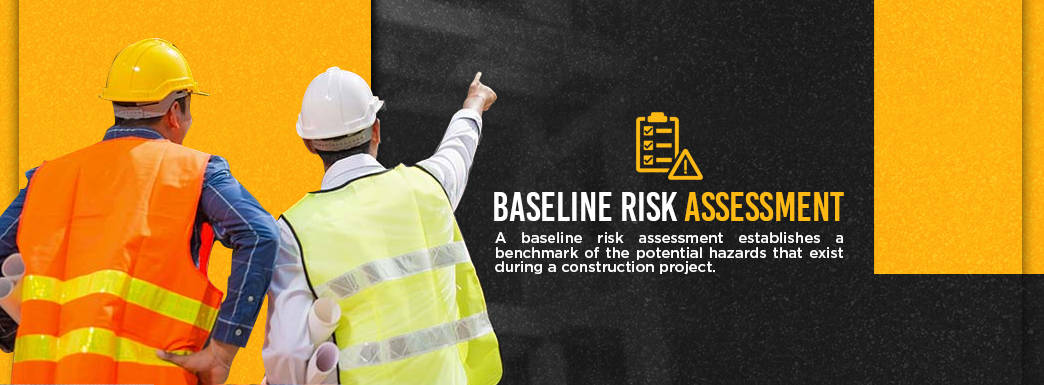
Issues-Based Risk Assessment
An issues-based risk assessment identifies risks associated with a particular activity or task, rather than risks that affect a construction project as a whole. Often, an issues-based risk assessment gets performed after a baseline risk assessment, in response to the risks identified by the baseline assessment.
An issues-based risk assessment is an appropriate option when bringing new equipment onto a job site, when new information becomes available about a particular hazard or when an employee points out a problem that could pose a risk to their safety or the safety of others on the construction site.
Continuous Risk Assessment
A continuous risk assessment is one the team performs regularly. Continuous risk assessment often involves hazard awareness, such as reminding employees to keep alert for and to report any issues or concerns on the job site. It can also involve the use of checklists before any work begins for the day or before a person begins using a piece of equipment to make sure there are no hazards or concerns present. An inspection, either by a manager or by a third party, is an example of a continuous risk assessment.
We identify and mitigate hazards and put protective measures, including signage and personal protective equipment, into place before we begin any job. Get in touch with us before starting your next project for a thorough risk assessment.
| Contact Us | Call Us |
Construction Project Risk Assessment Checklist: How to Perform a Risk Assessment
Ideally, the person who performs a risk assessment at a construction site will be someone who is familiar with the project, with construction in general and who has a good idea of the issues at hand. The risk assessment process typically involves four steps.
1. Identify Hazards
You want to classify any hazards that might be present on the job site or that might arise during a project. One way to go about identifying hazards and the risks connected to them is to think of specific tasks that will be part of the project. From there, you can assess any dangers that could come up and what the risks connected to them might be. When looking for these liabilities, remember to:
- Keep the big picture in mind.
- Refer to accident reports from past projects for an idea of hazards that were a concern previously.
- Account for anyone who might be present at the construction site, including visitors such as clients and delivery drivers.
- Take unusual conditions, such as a severe storm or power outage, under consideration.
- Examine equipment to see if altering it could change its safety features.
- Consider different groups of employees, as risk level can vary based on experience or overall health.
2. Assess the Risk the Hazards Present
The next step is to determine the severity of the risk a hazard creates. You want to evaluate not only how likely a particular hazard is to cause harm, but how bad the harm could be. When analyzing risk, consider dangers that are present under normal, day-to-day circumstances, as well as during unusual periods, such as when there’s severe weather, an emergency or a power outage.
To get a sense of the potential risk presented, review any information available, such as the operator’s manual for equipment, safety data sheets, inspection reports, test results, accident reports and studies from reputable third parties.
When ranking risks, you can evaluate the severity of the risk as well as the probability of it. For example, the severity ranking of a risk can range from low to high. A low risk might be one that results in a minor injury, such as a cut or bruise. A high risk might be one that causes a fracture, fatality or the loss of a significant amount of blood.
A highly probable risk might be one that is likely to occur at least once a year, while a less probable risk is one that is likely to occur just once during a lifetime.
3. Identify Actions You Can Take to Minimize or Reduce Hazards
Generally speaking, there are several actions you can take to minimize the risk particular hazards present. One option is to eliminate the risk by removing the danger. For example, you can send employees home if wet weather makes the construction site slippery, increasing the chance of falls.
Another option is to introduce controls that will either eliminate a hazard or reduce it enough that it no longer presents a significant risk. For example, if one piece of equipment is particularly hazardous, you might replace it with a safer one, such as a newer, more reliable model. You might make administrative changes to the work site, so workers only work between certain hours such as when there is still daylight, or you might introduce a buddy system, so no employee ever works alone.
4. Confirm You Have Corrected the Hazard
The final step in risk assessment is to verify your team has corrected the hazard, either by eliminating or minimizing it. After that, it’s essential to continue to monitor the situation to ensure any risks remain minimized and to confirm additional ones haven’t come up.
Contact us today for a risk assessment and to start your next job. We identify and mitigate hazards and put protective measures, including signage and personal protective equipment, into place before we begin any job.
| Contact Us | Call Us |
Common Risk Factors in Construction Projects
Although it’s common to associate risks and hazards with issues that cause physical harm, the scope is somewhat broader than that. During a construction project, risks can also include any problems that cause the project to go over budget or that interfere with the ability to complete the project on schedule. Common risk factors any manager should be aware of include the following.
- Occupational risks: Occupational risks include behaviors or equipment that can lead to injuries, such as a distracted employee or faulty equipment.
- Project risks: Project risks include a lack of project management, which can make a project take longer than planned or put workers at risk for injury due to poor supervision.
- Contractual risks: Contractual risks include missing deadlines, which can negatively affect the relationship between the management of a building and the construction company.
- Financial risks: Financial risks associated with construction projects can include an increase in the cost of materials and equipment.
- Natural risks: Natural risks include severe storms and other extreme weather events that might cause a construction site to shut down for one or more days.
Site-Specific Risk Assessment Examples
When performing a construction risk assessment, it is crucial to make sure that the assessment is site-specific, meaning it is project-specific and considers the conditions of the site and the requirements of a particular project. To understand how a site-specific risk assessment works and what one might look like, it can be helpful to look at specific examples.
In one instance, the owner of a building hired a manager to perform a risk assessment for the maintenance of the building. As part of the inspection, the manager walked around the building, reviewed accident reports and talked to the people who would be performing the maintenance work. They then noted who the hazards would affect, what controls were currently in place and whether those controls were sufficient.
In another case, a bricklaying company performed a risk assessment after winning a contract. The goal of the evaluation was to demonstrate the company’s approach to health and safety. As part of it, the manager of the company discussed work practices and hazards with employees, reviewed data sheets for mortar and read the manufacturer’s instructions for equipment and tools. Next, the manager recorded current controls in place for specific hazards and determined who was responsible for further actions.
Four Safety Precautions During Maintenance Work
Risk assessment isn’t only vital during construction projects to create a building. It’s also essential for any maintenance of an established building. When performing maintenance on a building, keeping the following in mind will help ensure your project is a safe one.
- Encourage communication: The employees working on a maintenance project can be excellent resources when it comes to detecting any concerns. Encourage people working on a site to speak up if they notice anything is amiss or if something feels off.
- Choose appropriate controls: Risk and hazard control should include elimination or substitution to minimize the risk, encouraging safe work practices, making administrative changes and issuing protective gear as needed to employees.
- Have a plan for non-routine operations: Along with having a plan for controlling day-to-day risks, it’s crucial to have a strategy in place should an unusual circumstance, such as a hurricane, a thunderstorm or a fire, which can create a unique set of hazards for a maintenance project.
- Check in regularly: As with risk assessment for a construction project, it’s a good idea to check in on the hazards and risks that can arise during a maintenance project.
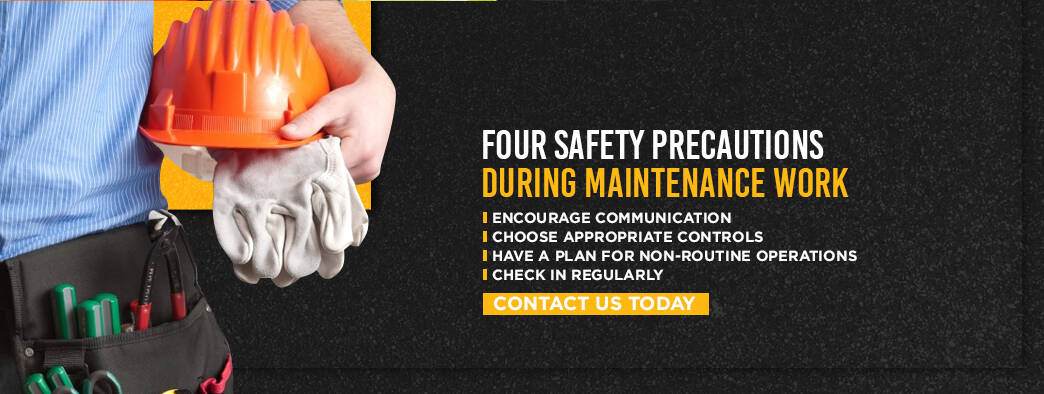
The goal of any building or construction manager should be to protect the employees and craftspeople who are working on a construction site or performing a maintenance project. Performing a risk assessment before any project begins is one way to lower the risk of injury. Risk assessment can also protect the project itself by making sure it stays on deadline and on budget.
Houck puts safety first. That’s why we’ve made it the first part of our slogan: “Safety. Quality. Performance.” Before we begin any job, we identify and mitigate hazards and put protective measures, including signage and personal protective equipment, into place. Contact us today to learn more about the construction industry, our services or about available careers at Houck.
Trends That Are Poised to Impact Construction
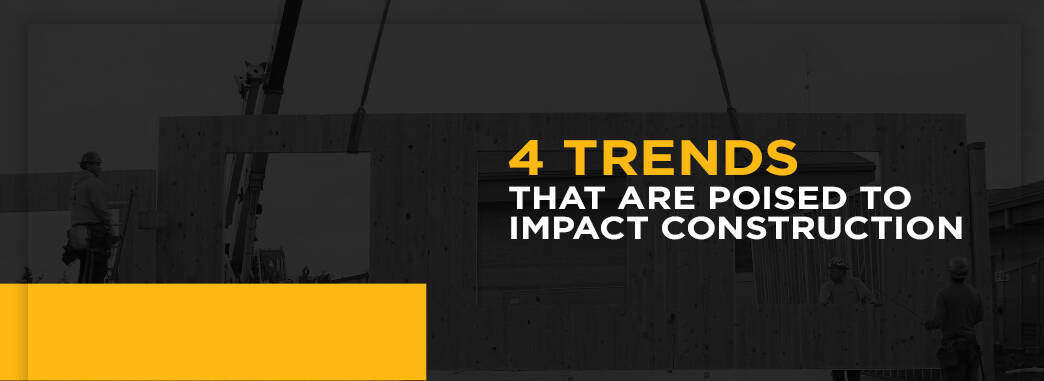
Construction is a dynamic field, and upcoming advances will noticeably shift many parts of the industry. From smart personal protective gear to self-healing concrete, the future is set to introduce surprising innovations to the construction industry.
Although you have tried-and-true procedures and strategies, you can complement your expertise with fresh resources and techniques. These trends can streamline your operations, enhance your safety protocols, increase the quality of your work and drive your performance.
We compiled this list of trends that are poised to impact construction, and the main changes lie in four segments — materials, sustainability, technology and safety.
Importance of Tracking Construction Trends
Just 20 years ago, construction teams relied on paper plans to guide their projects, but digital records now dominate construction procedures. It’s evident that new demands, methods and technology are regularly rising in the industry. Even within the last year, many trends have appeared, grown stronger or dissipated.
Observing the industry’s trends is crucial for construction professionals. If you aren’t aware of changes in construction, your techniques become outdated, and your business suffers. Although you can stand out in your experience, you can quickly fall behind if you don’t prioritize progress. As you service clients, you can rise above competitors through continual growth. Your grasp on the latest tools and resources causes you to remain relevant through the years, and developments can enrich the quality of your work.
Learning from useful trends helps you stay at the forefront of the field. Tracking construction industry trends can promote on-site efficiency and limit the disruption of day-to-day operations. For instance, modern, rigorous safety measures can prevent setbacks from damages or injuries. To lead the industry and hone your skills, master innovative practices and expedite your procedures.
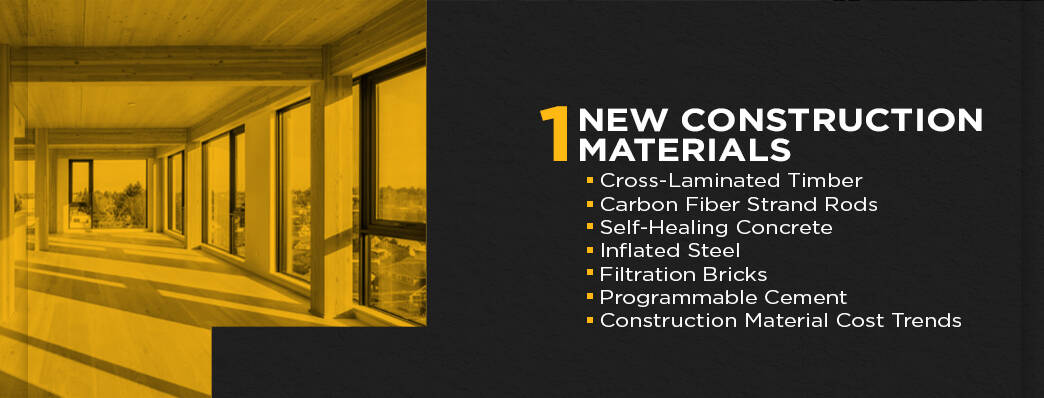
1. New Construction Materials
Materials often limit construction professionals, but many emerging supplies are adding fresh potential to the industry. Strategically engineered supplies feature versatile and helpful features, like inflated steel’s light-weight but durable composition. With commercial applications, new construction materials can push past previous barriers.
Cross-Laminated Timber
Recently, the industry started using cross-laminated timber (CLT). The layering process makes CLT stronger than standard wood, which creates resilient panels. It has a low environmental impact and can withstand high temperatures, making it a cost-effective alternative for floors and walls.
Carbon Fiber Strand Rods
Carbon fiber products are also becoming widely used, including strand rods and fiber-based balsa. With carbon fiber’s flexibility and robust tensile strength, it can repair compromised buildings or equip structures for seismic activity. To retrofit buildings, rods consisting of thermoplastic carbon fiber reinforce structures and add an aesthetic appeal.
Self-Healing Concrete
A revolutionary material, self-healing concrete, is altering the lifespan of building and bridge foundations. The formula is inspired by ancient Roman concrete, and the combination of ingredients withstands corrosion over time. After cracks form, a chemical reaction produces additional material to fill the fissures. Self-healing concrete fixes the common issue of cracks and crumbling structures.
Inflated Steel
Recently, it became possible to fill thin steel sheets with air and stabilize them. After welding steel pieces together, manufacturers can pump air into the pocket while pressurizing the steel. Inflated steel enhances the inherent strength and stability of steel sheets while keeping components lightweight. The possibilities of inflated steel structures are promising, particularly in roofing and bridges.
Filtration Bricks
Filtration materials, like passive air-filtration bricks, can reduce pollution and boost air quality for construction clients. These breathable bricks remove toxins and particles from the air by directing airflow through a cyclone-like path. The rectangular concrete masonry blocks are arranged to form a barrier along with vertical supports. In the long-run, filtration bricks can save clients money and purify building interiors in places with poor air quality, like congested cities.
Programmable Cement
Normally, cement is vulnerable to chemical and water damage, but newly discovered properties can alter the aggregate. By adding charged compounds that diminish surface tension, manufacturers can control cement’s density. Rather than letting the cement retain a haphazard structure, cement is programmed to include deliberate molecular shapes. This leads to a tighter material that resists wear and tear.
Construction Material Cost Trends
In 2018, the cost of popular construction materials rose 7.4 percent due to increasing pressures, but input prices are projected to decline. Overall, the industry has been grappling with increasing expenses, and many contractors were accepting high costs without increasing client prices.
Policies were pushing the cost of steel and aluminum up, making critical supplies like beams and pipelines more expensive. The cost of steel mill goods was projected to spike regardless of new policies, but this trend amplified the change. Now, the availability and cost of these materials are evening out.
Rising material transportation prices have been contributing to financial strain on companies. However, natural gas prices have been fluctuating, but they’re currently falling, which could impact the current momentum of the market.
The cost of necessary goods like oil and copper have decreased in 2019, returning profit margins to a favorable level for construction companies.
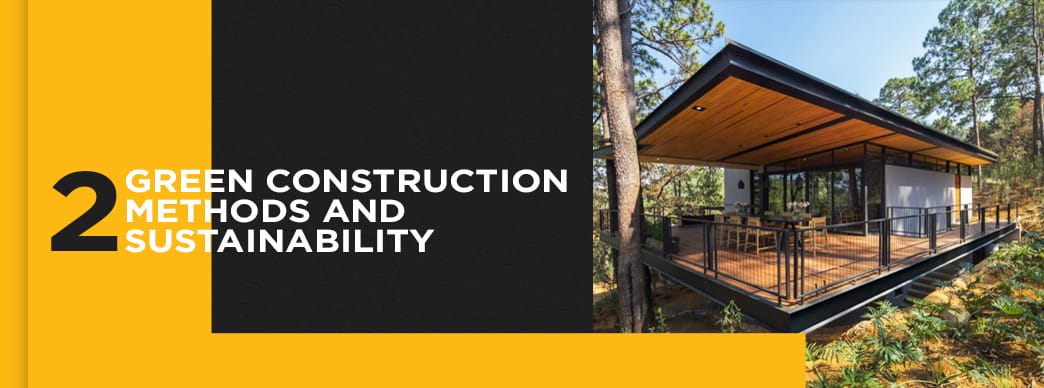
2. Green Construction Methods and Sustainability
Environmental considerations are extremely important to the public, and the construction industry is incorporating eco-friendly practices to accommodate these values. Sustainable construction prioritizes efficiency in resources and responsible building methods. Also, tax benefits and incentives push these efforts forward.
Concerns about waste in the construction process are being addressed through recycled building supplies. To cut back on the large amounts of landfill waste typically generated, workers are reclaiming material from old buildings and repurposing them in fresh projects.
A popular trend, zero net energy buildings, takes sustainability to another level by attempting to eliminate energy consumption. Each site generates the energy it needs through solar, wind or geothermal sources. Various internal and external systems help these buildings become self-sufficient.
There’s a shift toward designing structures to endure, too. Long-lasting designs are accounting for future degradation and environmental disasters. Long-standing buildings can diminish the amount of demolition and repairs that add to landfills.
Over time, sustainable construction is cost-effective, especially for clients, and beneficial for the environment, as green methods release fewer pollutants into the atmosphere. Endeavors to decrease the carbon footprint in construction are positively impacting society and slowly gathering speed.
3. Technology Trends in the Construction Industry
As in most industries, technology has transformed how professionals conceive construction plans and craft buildings. Evolving technology continues to enhance construction procedures and open solutions to reoccurring challenges. From robotics to revolutionary software, the latest technology trends in construction are modernizing the most basic construction tasks.
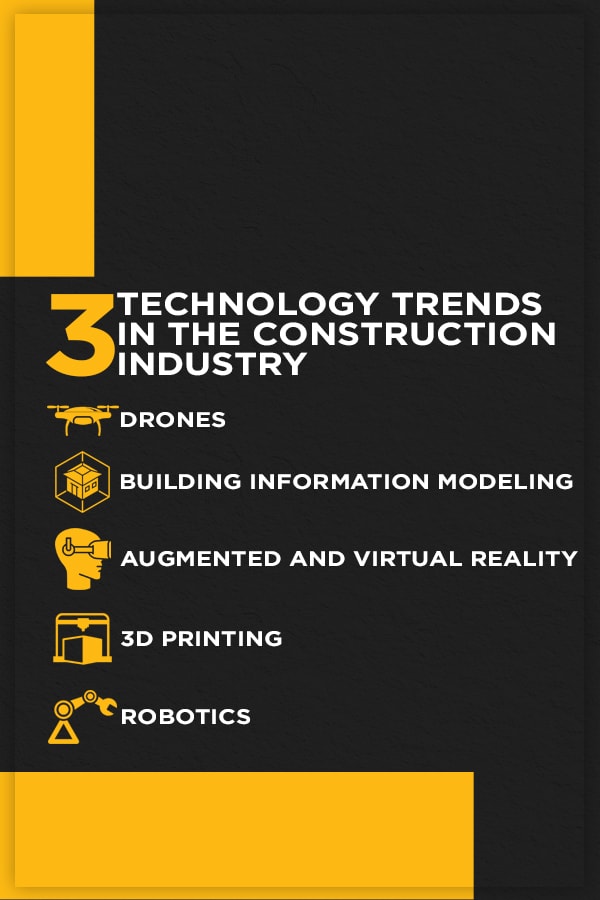
Drones
Traditional surveying methods can have human error and take several days. Thanks to drones, land surveying is finished in minutes, substantially conserving labor, time and money. Now contractors rely on drones to collect vital data for projects, and supplementary software can quickly analyze the data they gather. Drones can also help managers and supervisors monitor the productivity of workers, and this surveillance is valuable for security purposes, too.
Drones make on-site communication easier, as the instant visibility of an expansive area can convey more than audible reports from workers. This maintains a steady workflow and prevents setbacks to schedules.
Building Information Modeling
Continually a popular process, building information modeling (BIM) has increased thoroughness in the exchange of data and development of projects. However, it continues to grow with the emergence of cloud systems. With streamlined details and intelligent multi-dimensional modeling, BIM allows every involved party to review projects without wasting time.
Augmented and Virtual Reality
Augmented reality (AR) and virtual reality (VR) can prepare and guide workers through projects. These devices, which are usually headsets, can present the anticipated construction steps and simulate building models.
VR replaces the need for setting up intensive scaled miniatures of sites or for visiting physical locations to walk through the specifics or check on progress. Building owners and commercial property managers can also display their available spaces to customers without waiting for the project to finish.
Projecting possible designs through AR can give further dimension in the planning stages of construction. AR gadgets can allow construction professionals to interactively assess sites and walk through their intended plan before starting. This promotes accuracy, as teams can gather extensive information and catch miscalculations early.
3D Printing
The field must overcome some limitations, but 3D printing technology can offer customization and adaptability. These machines can form complex pieces or buildings in a range of materials.
Some companies have already been successful in printing entire structures, but the industry is still easing into the idea of printing materials. Large structural components can be fabricated onsite or at another location, so transportation is no longer a necessary part of the process.
As 3D printing gains traction in construction, it could reduce supply costs. There is also more certainty in production, as the machines can execute exact measurements.
Robotics
While the medical field has understood the potential of robotics for a while, this trend is just taking off in the construction industry. Construction professionals can use robotics to perform precise physical tasks on job sites.
As robotics become more mainstream and advanced, they may be able to replace human labor. If the shortage of skilled workers persists, robotics could offset this issue. Several processes must become automated before construction fully embraces this trend, but eventually, robotics could play a role in welding or bricklaying.
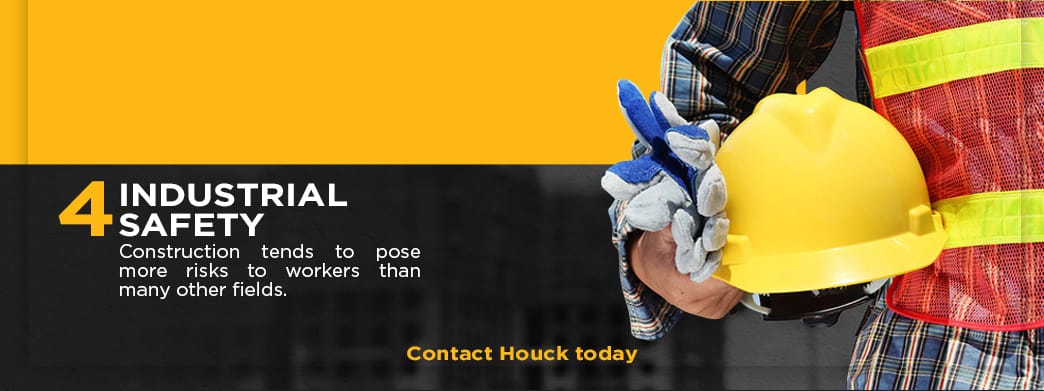
4. Industrial Safety
Construction tends to pose more risks to workers than many other fields. In 2017, 20.7 percent of worker deaths in the U.S. private industry were in construction. However, improved safety measures and resources are working to keep construction professionals from harm. Additional training is a worthwhile solution, but new technology is also furthering safety efforts with intelligent monitoring and protective gear.
Falls and fatal encounters with heavy equipment account for many construction accidents, and preventive devices can catch these situations before they happen. Devices connected to the Internet of Things (IoT) can predict hazardous areas to warn workers and managers. Workers can avoid industrial accidents with IoT gadgets, specifically wearable electronics. With the real-time evaluation of the setting, workers can benefit from this reliable support.
Increasing personal protective equipment is another common trend in industrial safety. Smart helmets with built-in communication are connecting workers so they can share necessary updates on-the-go. Earmuffs and headsets with smart features can reduce noise damage and maintain clear correspondence on loud sites. Wearable electronics can relay changes in health to EMTs or signal a worker’s fatigue to supervisors.
Managers are setting rigorous safety expectations on job sites, and surveillance through cameras equipped with artificial intelligence (AI) is aiding the push for protective gear. AI can also learn behavioral patterns and report when workers are misusing equipment. Accountability can spur your workers on to pay attention to protocol.
Smart cameras are also being used to detect exposure to toxic chemicals. Contaminated air from gas leaks can be detrimental, but camera sensors with a unique imaging spectrum can rapidly pinpoint leaks. Automated warning systems can gauge the extent of the problem and alert those on the project site to get to safety.
Impressive Growth for the Future of Construction
The future of the construction industry is complex, but there are significant signs of positive growth. While there are setbacks, real output and the availability of emerging technology are reasons for optimism. Long-term, the industry is moving forward into a balanced state in terms of employment and revenue.
The most compelling indication of growth is the outlook of employment in the coming years. Construction is expected to have the largest industry increase in employment by 2024 compared to other sectors. Better recruitment and retention of employees can attract more workers and create desirable job conditions. Technology within construction is also generating jobs as more technicians and engineers are needed. The output from construction is also set to surge, influencing other industries like real estate.
Costs for materials and transportation have been high, but experts expect them to plateau. Contractors should be able to boost revenues as the sector expands.
Economic growth can offer construction professionals plenty of opportunities. Commercial investments from the government and increased consumer spending both set up construction entities for success. Concentration on green building projects is one factor in support of this upward trend. Remodeling, historic renovations and additions serve as viable sources for shaping the time ahead for industrial construction. The following years could bring the stability the construction industry has been lacking.
Keep up With Trends in Construction
As a whole, the construction industry has experienced obstacles but is recovering and moving toward a prosperous period. Trends in materials, sustainability, technology and safety are fortifying construction professionals and revamping their practices. You can progress in your industry knowledge to lead the way in construction innovation.
Remain aware of the changes in the industry to take advantage of promising methods and new technology. You can hone your skills and gain further insight as you watch construction grow.
At Houck, we are dedicated to safety, quality and performance. With over 70 years of experience, we are highly specialized in building restoration and maintenance services. Contact Houck today to request our construction services, learn more industry information, or inquire about Houck career opportunities.